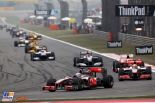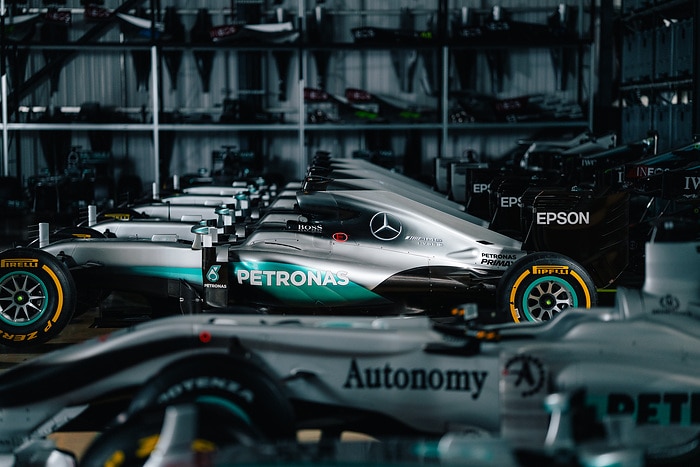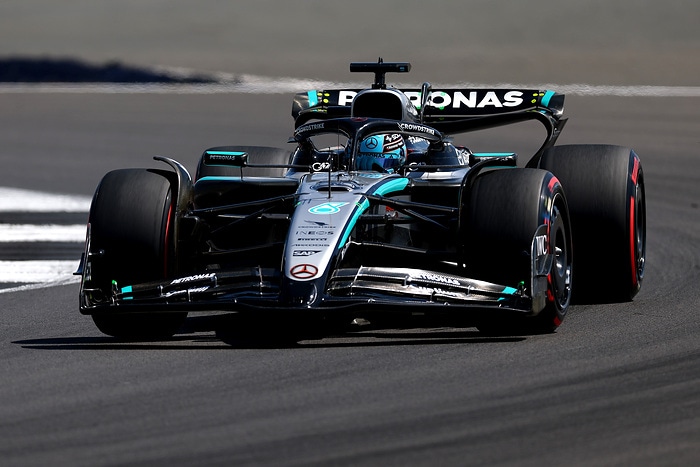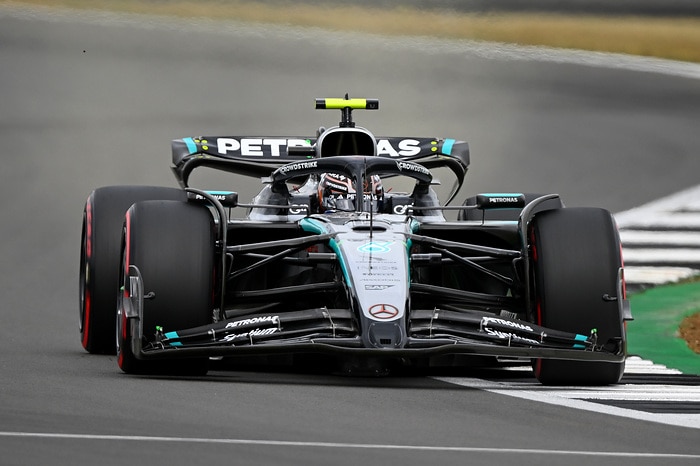
12:48 – McLaren has announced that it will part ways with Honda at the end of the 2017 campaign, in favour of a three-year Renault engine supply deal. GPUpdate.net charts the partnership from beginning to end.
November 16, 2009 – Mercedes announces that it has bought out the Brawn Formula 1 team, returning the manufacturer to works status for the first time since 1955. McLaren, powered by Mercedes since 1995, consequently loses priority, but the engine partnership is renewed through to 2015. “We’re delighted that Mercedes-Benz has committed to continue not only as an engine supplier but also as a partner of ours until 2015 – and perhaps thereafter,” says then boss Ron Dennis.

2010/11 – McLaren continues to fight at the sharp end of the Formula 1 grid while Mercedes holds fourth place, adrift of the leading teams. Mercedes, meanwhile, begins to concentrate the bulk of its attention on the new-for-2014 regulations, with the power units receiving their first test run on the dyno towards the end of 2011. At the same time, rumours persist that Honda will return to Formula 1 with McLaren, potentially as early as 2014.
May 16, 2013 – McLaren and Honda confirm that the two parties will reunite for the 2015 Formula 1 season, rekindling a partnership that delivered multiple titles in the late 1980s/early 1990s.
2014 – Mercedes vaults to the front while McLaren is mired in the midfield, amid suggestions that the manufacturer has provided lacklustre service and sub-par treatment, compromising McLaren’s prospects, while ensuring Honda cannot learn from the Silver Arrows’ power unit.

November 25, 2014 – Following a brief shakedown at Silverstone, Stoffel Vandoorne gives the Honda-powered MP4-29H/1X1 a public run during the two-day post-race test following the Abu Dhabi season finale. Vandoorne manages only five full laps across the two days, amid problems, with the car twice stopping out on track. “We all want to go into Melbourne thinking we can win the race,” says an optimistic Eric Boullier.
December 11, 2014 – McLaren confirms that it has signed Fernando Alonso on a three-year deal to partner Jenson Button. “I am joining this project with enormous enthusiasm and determination, knowing that it may require some time to achieve the results we are aiming for, which is no problem for me,” explains Alonso.
February 1-4, 2015 – McLaren’s MP4-30 makes its debut at Jerez but the car is unreliable, finishing bottom of the mileage charts, while the best lap is seven seconds off the pace. The team, however, insists that there is nothing to worry about.

February 22, 2015 – Fernando Alonso crashes heavily through Turn 3 at the Circuit de Barcelona-Catalunya and is hospitalised as a precaution, with the cause of the accident remaining a mystery. Alonso ultimately withdraws from the final test, and opening race in Australia, as technical problems persist, leaving the team firmly on the backfoot.
March 15, 2015 – The first race of the partnership is a troubled affair. McLaren qualifies as the slowest team while Kevin Magnussen is unable to even take the start after smoke trails from his engine on his reconnaissance lap. Jenson Button finishes as the final classified runner in 11th place, having been lapped twice by race winner Lewis Hamilton.
May 24, 2015 – After a string of difficult events, as it becomes clear that Honda lacks energy deployment at the end of straights, the partnership scores its first points in Monaco, as Button comes home in eighth place. Further problems follow across the summer, amid difficulty developing due to the token system, before a double top 10 finish is achieved in Hungary.

Mid-2015 – Honda insists the relationship with McLaren remains healthy, and continues to target podium finishes across the remainder of the year, despite engine penalties racking up. However, motorsport boss Yasuhisa Arai comments: “We knew it wouldn’t be easy, but perhaps we didn’t imagine that it would be this hard.”
November 14, 2015 – Alonso, having humiliated Honda at Suzuka by labelling his power unit a “GP2 engine”, stops on track during qualifying at Interlagos. Alonso slumps trackside in a deckchair and briefly sunbathes, before he and Button make their way to the podium, demonstrating some black humour.
November 29, 2015 – McLaren finishes the year in ninth position in the Constructors’ Championship, having amassed just 27 points, taking points in only five of the 19 Grands Prix.
February 23, 2016 – Honda confirms that it has replaced Arai with Yusuke Hasegawa.
Pre-season 2016 – McLaren-Honda demonstrates improved pace and reliability, putting itself into the midfield fight. Button labels the gains the “biggest improvement yet”, while Hasegawa says Honda was able to “confirm the improvements in reliability, deployment and engine performance that we focused on during the off-season”.

Mid-2016 – Honda remains the weakest power unit but gains enable McLaren to fight in the midfield, regularly finishing in the points, as reliability also improves. Boullier labels the transformation from 2015 to 2016 as “day and night”, and tells GPUpdate.net: “Based on where they are today and what we expect them to step up, we will get there. We will get there. I don’t know if it will be in six months, one year or two years. But we will get there.” Boullier also hints that the new 2017 regulations can be seen as a reset for everyone – including McLaren.
November 15, 2016 – Following years of power struggles, Ron Dennis announces that he has been forced to stand down as Chairman and Chief Executive Officer of the McLaren Technology Group, ending his 36-year tenure. Six days later, Zak Brown is appointed to head the team, while two months later Formula 1 CEO Jost Capito departs, amid a winter of upheaval in management roles.
November 27, 2016 – McLaren finishes the season sixth in the championship, with 76 points, an improvement of three positions on 2015, having taken points finishes in 13 of 21 Grands Prix.
January 7, 2017 – McLaren confirms that Honda has redesigned its power unit, aided by the removal of the token system, believing that the 2015/16 approach had a lower performance potential than the revised design. Honda reveals in February that it is a “high risk” approach.

February 24, 2017 – McLaren unveils a new-look for 2017, mixing orange with black, in a nod to its team history. Alonso says the team is aiming to look “respectable”, while commenting: “The start of the season will be a challenge. But I’d like to think we can target the second half of the year as a time when we’ll really be able to start making useful performance steps.”
March 8, 2017 – Pre-season testing turns out to be an abysmal period for the partnership, amid an absence of reliability and performance at the Circuit de Barcelona-Catalunya. Alonso comments: “We have only one problem at the moment and that is the power unit; there is no reliability and there is no power… I think we are around 30 km/h down on the straight, every straight.” Boullier admits the partnership is at “maximum strain”. Hasegawa concedes Honda is slightly “scared” about its performance deficit.
March 16, 2017 – Reports emerge that McLaren has sounded out Mercedes regarding a potential power unit supply for 2018. “Together with Honda we are considering options,” a spokesperson tells GPUpdate.net, without rejecting suggestions that such a situation has occurred.

March 26, 2017 – Alonso makes it through to Q2 before retiring with a suspension issue at the Australia season-opener, while Vandoorne finishes at the back, two laps down. “I think in normal conditions, at a normal circuit, we should be last,” says Alonso.
April 12, 2017 – McLaren announces that Alonso will participate at the Indianapolis 500 rather than the Monaco Grand Prix, following a tie-up between the team, Andretti and Honda.
April 28, 2017 – At just the fourth event of the year in Russia, Vandoorne takes on his fifth engine elements, earning him a grid penalty for exceeding his allocation. Alonso, meanwhile, estimates McLaren is losing 2.5s/lap on the straights, before his car fails on the formation lap. “Every weekend is the same,” comments Alonso.
April 30, 2017 – Honda announces that it will supply Sauber with power units in 2018, “in addition to the partnership with McLaren”, which labels the new deal a chance to “double R&D” for the Japanese manufacturer.
May 25, 2017 – Brown outlines to GPUpdate.net that McLaren will stick with Honda in 2018, commenting: “We have been very consistent and we are committed to Honda – there will be no change.”

May 28, 2017 – Alonso competes at the sharp end of the pack during his run at the Indianapolis 500, only to retire due to an engine failure.
June 7, 2017 – Brown comments that McLaren has “serious concerns” over Honda, believing the engine supplier to be “a bit lost”. “Our preference is to win the World Championship with Honda,” he says. “But at some point you need to make a decision as to whether that’s achievable. And we have serious concerns. Missing upgrades, and upgrades not delivering to the level we were told they were going to, you can only take that so long. And we’re near our limit.”
June 8, 2017 – As doubts swirl over Alonso’s future, he makes an emphatic statement in Canada, declaring: “If we are winning before September or something like that, [when] I will make a decision, then I will stay.” Clearly, it is noted by observers, McLaren will not be winning by September…
June 9, 2017 – As the situation deteriorates, Brown says of McLaren’s 2018 options: “We have a plan B, a Plan C. We have some plans.” Hasegawa responds, stressing: “It is very unfortunate that we can’t give them a good [power unit], we can’t convince them that we can do that. Of course, we need much improvement from the performance and reliability point of view – we will do everything and we need to do everything.”

June 11, 2017 – Following a dismal performance in Canada, as the team remains rooted to the foot of the standings, without a point, Brown declares that McLaren will take a “proactive” approach to the situation.
June 17, 2017 – After a barrage of criticism across the Canadian weekend, Hasegawa accepts Honda is “frustrated” by its predicament, but it does not mean McLaren wants “a divorce”.
June 20, 2017 – Mercedes boss Toto Wolff insists the manufacturer will “not interfere” in the McLaren/Honda saga. “This is not our priority at the moment,” he tells GPUpdate.net. “First, we would like to see Honda and McLaren sorting out their relationship. If you are being considered as the new bride, you want the couple to divorce first, before you jump into the bed.”
July 7, 2017 – After an evaluation during practice in Azerbaijan, and Alonso scoring the team’s first 2017 points in an attrition-filled race, Honda brings its Spec 3 power unit to Austria. Only Vandoorne runs it in the race after Alonso suffers reliability problems following Friday practice.

July 19, 2017 – Brown outlines that Alonso wants to stay at McLaren, before commenting: “The relationship with Honda has been and remains fine on a personal level, but as we’ve made it widely known we need a much more competitive power plant and that is the conversation we’re having. We’re continuing to have conversations with them in how we’re going to get ourselves more competitive next year.”
July 27, 2017 – Sauber announces that it has cancelled its planned partnership with Honda for 2018, with Honda revealing that “differences in the future directions of both parties” were behind the split.
July 30, 2017 – McLaren has its most competitive run of the year, aided by the reduced importance of power at the Hungaroring, as Alonso takes sixth, with Vandoorne 10th, finally moving the team above Sauber in the championship.
August 2017 – Boullier outlines that McLaren has a September deadline to decide its 2018 power unit partner, while Honda feels that latest improvements have brought it to the level it expected to be at during testing, effectively leaving it half a season behind its development curve.

August 24, 2017 – Honda accelerates development by bringing an updated engine to Belgium – with Alonso running Spec 3.5 and Vandoorne using Spec 3.6, though the Spaniard plays down the upgrades.
August 25, 2017 – Renault boss Cyril Abiteboul confirms speculation that the French company has held discussions with McLaren, but plays down the connection, commenting that “they [McLaren] are not necessarily pushing for anything”.
August 26, 2017 – Honda explains that it hoped to bring its Spec 4 power unit to Belgium but “failed”, while Vandoorne suffers a problem with Spec 3.6, and reverts to Spec 3.5.
August 31, 2017 – Honda deliberates over whether to run Spec 4 at Monza but settles on trialling Spec 3.7. Meanwhile, Alonso quashes suggestions that he has issued a ‘me or Honda’ ultimatum to McLaren, labelling such talk as “absolutely not true”.

September 1, 2017 – Hasegawa confirms to GPUpdate.net that it is “very clear” Alonso does not want to commit to Honda, unless substantial gains can be made. “If we don’t introduce anything, and stay with the current performance, McLaren or Fernando doesn’t stay with us – it is very clear,” Hasegawa laments.
September 2, 2017 – Amid rain delays at Monza, representatives from Renault, and Red Bull’s Christian Horner, are seen entering McLaren’s Brand Centre in the paddock.
September 3, 2017 – Brown comments that it is “very likely” Alonso will stay with McLaren for 2018, if it uses Renault power.
September 15, 2017 – After almost a fortnight of rumours, McLaren finally confirms that it will part ways with Honda at the end of the season, moving on to a three-year supply deal with Renault, covering 2018-20. As part of the domino effect, Toro Rosso will pick up Honda’s power unit, with Carlos Sainz Jr. being loaned out by Red Bull to Renault.
Source :http://feeds.gpupdate.net






















